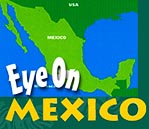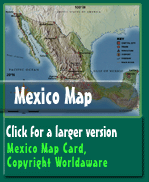|
|
|

Like many large countries, Mexico is a land of great variety. It has high snow-capped mountains with active volcanoes, narrow coastal lowlands with sandy beaches, tropical rainforest and hot deserts. The Rio Bravo (Rio Grande) is easily Mexico's longest river. It forms much of the border with the USA. Most of Mexico's other rivers are fairly short. However, there are many lakes, the largest being Lake Chapala (near Guadalajara).
There are two main chains of mountains called the Eastern and Western Sierra Madre. They are found in two lines parallel to the coast and running from the north west to the south east. Although the average height of the mountains is about 1000 metres above sea level, the highest point reaches 5,700 metres. Many of the mountain peaks are volcanoes, some of them active. Two of the most famous are Popocatepetl and Paricutin. Paricutin was formed in 1943, growing over 300 metres in just six days.
Mexico also suffers from other natural hazards. Earthquakes are quite common. Fortunately they aren't all as violent as the one which struck Mexico City in 1985. It measured 8.1 on the Richter Scale, killed ten thousand of people and destroyed large areas of the capital city. Although Mexico escaped from the worst effects of Hurricane Mitch in 1998, hurricanes are a threat in late summer and early autumn as tropical storms build up off the Gulf of Mexico.
 
|
|
|
|


